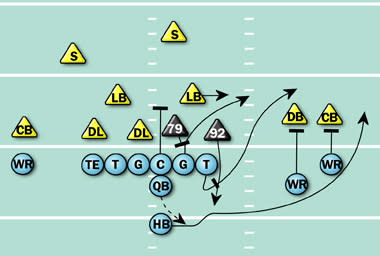Bucs need flexible approach on D-line
Also in this article:
Next Surveillance:
Raiders
More NFL:
Editor's note: Yahoo! Sports will examine the biggest weakness of the 2009 season for every team and explain how the franchise can address the issue. The series continues with the Buccaneers, who finished fourth in the NFC North (3-13).
Biggest problem in 2009: A vulnerable inside run defense

DT Gerald McCoy(notes) during the Buccaneers rookie minicamp.
(Photo by J. Meric/Getty Images)
For the Tampa Bay Buccaneers, the days of the front sevens led by Warren Sapp(notes) and Derrick Brooks(notes) might as well be a million miles away. Far from a Super Bowl-caliber defense, the 2009 Bucs allowed opposing running backs to gain league highs of 4.8 yards per carry, 158.2 yards per game, and 25 rushing plays of 20 yards or more. Led by tackles Chris Hovan(notes) and Ryan Sims(notes), the Bucs were especially soft up the middle – no team allowed a higher yards-per-play average between the offensive guards than Tampa Bay's 4.77, according to Football Outsiders.
After the 2009 season, the team took drastic action: it released Hovan and kept Sims on purely as a backup. Then, in the NFL draft, the Bucs took defensive tackles with their first two picks: Oklahoma's Gerald McCoy went No. 3, and UCLA's Brian Price(notes) was taken with the 35th overall pick. While both players will make a difference on that Tampa Bay line, there's one problem: Neither one of them are big enough to take the traditional nose tackle position in a four-man front. That's fine in the traditional Tampa 2 if you have the talent to make up for it – Sapp was a 300-pounder who played as if he was 30 pounds heavier from an impact perspective – but Price, at 6-foot-1 and 300 pounds, might find the move to nose tackle at the NFL level to be a major adjustment. And McCoy, who stands 6-4 and weighs just 295 pounds (the average size of a 3-4 end), has a tendency to get lost in scrums and double-teams for all his initial drive and burst.
The Colts have succeeded with smaller interior defenders in the past with tackle stunts and specific linebacker positioning, but it's generally a patch job, hidden by the fact that Peyton Manning(notes) forces opposing offenses to play catch-up with the pass. To see how the Bucs can overcome size issues in the middle, let's look at another light defense, and a coordinator who adjusted with scheme.
The 2010 solution: Create read-and-react situations with flex positioning

The '09 Broncos switched to a 3-4 defense, despite the fact that they had no one on their line heavy enough to play the traditional nose tackle role. Ronald Fields(notes) started all 16 games for the Broncos at nose tackle at 6-2 and 314 pounds – at least 10 pounds lighter than the usual 3-4 nose. At 6-3 and 314 pounds, Marcus Thomas spelled Fields at times. Former defensive coordinator Mike Nolan adjusted by installing different "flex" packages, which took Fields and other linemen just off the line of scrimmage so that they could read blocking schemes and would not be overwhelmed by initial blocks. The concept was invented by legendary Cowboys coach Tom Landry as a response to the Vince Lombardi power sweep, and mirrored Lombardi's own ideas about zone blocking. The Flex is sort of a zone front – defensive linemen are initially responsible for areas as opposed to blockers. This is how the Broncos ranked 15th in the NFL in those same Football Outsiders stats up the middle against the run.
In the diagrammed example, Thomas (79) is flexed off the line with 1:38 left in the first quarter of Denver's Week 14 loss to the Colts. End/linebacker Elvis Dumervil(notes) (92) crashed right tackle Ryan Diem's(notes) outside protection and invaded the backfield, preventing running back Joseph Addai(notes) from heading upfield. Forced to juke his way outside right tackle, Addai ran toward the sideline, looking for a lane to exploit. But he couldn't cut back in on Thomas, because Thomas used the extra time given to him by the flex position to read the block from right guard Kyle DeVan(notes). Thomas saw DeVan coming up straight ahead; he knew he wouldn't have to deal with a trap or pull or slide protection. Thomas took a quick move inside and twisted out of the block, running along Addai's path and forcing him to extend his line out of bounds.
If the Bucs plan to move Price to the nose position as they say, they'd be wise to employ a few flex looks, giving Price that extra split second to read what's in front of him. It could be the difference between a new run-stopping front four, and the same problems with different names behind them.
